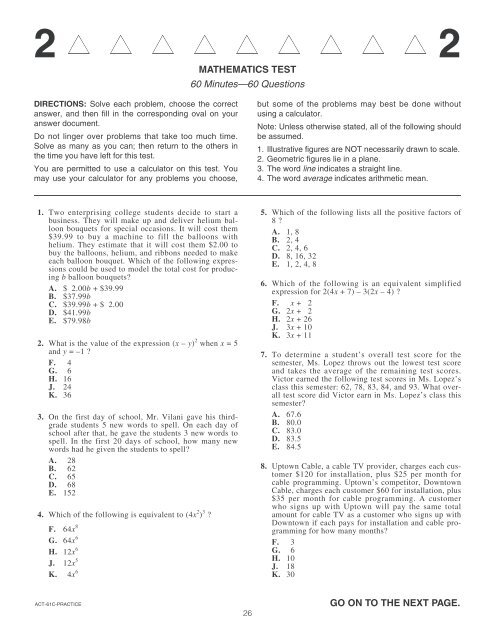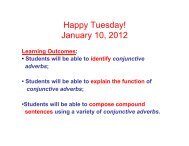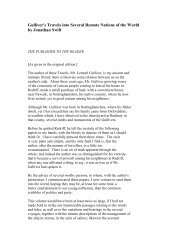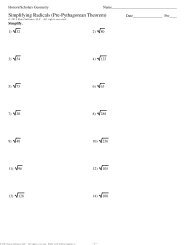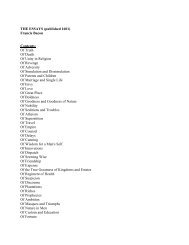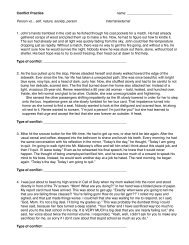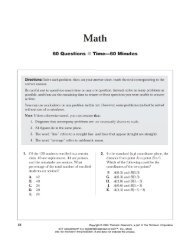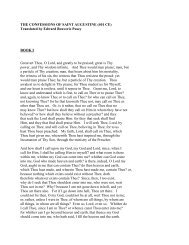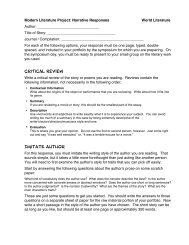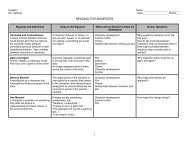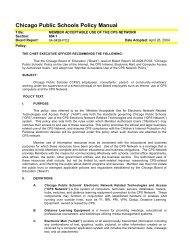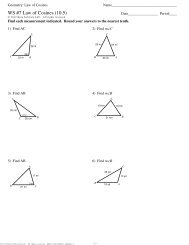Math Practice ACT 2007-2008 with Answer Key - Von Steuben ...
Math Practice ACT 2007-2008 with Answer Key - Von Steuben ...
Math Practice ACT 2007-2008 with Answer Key - Von Steuben ...
You also want an ePaper? Increase the reach of your titles
YUMPU automatically turns print PDFs into web optimized ePapers that Google loves.
Theorem 6.4. Let G be an infinite locally finite connected graph which admits a regular packing inR d . Then we have the following alternative: either G has a positive Cheeger constant, or there arearbitrarily large subsets S of G such that |∂S| < |S| d−1d +o(1) .By regularly we mean uniform upper bound on the ratio of the radii of neighboring spheres. Theproof of the last two theorems in [7] uses sparse graphs limits: by [13] local limits of bounded degreefinite planar graphs are a.s. recurrent for the simple random walk, in [7] the proof was adapted toshow that local limit of finite graphs that are regularly packed in R d , are d-parabolic. Which is thekey to the results above.Question 6.5 (<strong>with</strong> Oded Schramm). Show that any packing of Z 3 in R 3 has at most one accumulationpoint in R 3 ∪ {∞}.7 Perturbing the Euclidean metricSome families of metric spaces are naturally parameterized by the reals.The critical spaces areusually more exotic. We will present a few examples. These spaces sometimes admit combinationsof properties which are impossible in the vertex transitive world. We start <strong>with</strong> the classical modelof first passage percolation for perspective.7.1 First passage percolationOne natural way to randomly perturb the Euclidean planar metric is that of first passage percolation(FPP), see [38] and [32] for background. That is, consider the square grid lattice, denoted Z 2 , andto each edge assign an i.i.d. random positive length. There are other ways to randomly perturb theEuclidean metric and many features are not expected to be model dependent. Large balls convergeafter rescaling to a convex centrally symmetric shape.Richardson (1973) proved the first shapetheorem, when the length has exponential distribution and the graph is the Z d lattice. Simulationsindicate that the limiting shape is not the Euclidean ball. Kesten (unpublished) showed that theshape is not the Euclidean ball in high enough dimension.The boundary fluctuations are conjectured to have a Tracy-Widom distribution. The variance ofthe distance from the origin to (n, 0) is conjectured to be of order n 2/3 . So far only an upper boundnoflog nwas established, see [11]. Optimal bounds on the length of efficient algorithms for finding theshortest path or to estimate its length are still unknown.The structure of geodesic rays and two-sided infinite geodesics in first passage percolation is stillfar from being understood. Furstenberg asked in the 80’s (attending a talk by Kesten) to show thatalmost surely there are no two sided infinite geodesics for natural FPP’s, e.g. exponential length onedges.8
Test 2: <strong>Math</strong>ematics—Scoring <strong>Key</strong>SubscoreArea*<strong>Key</strong> EA AG GT1. A _______2. K _______3. B _______4. G _______5. E _______6. H _______7. E _______8. G _______9. B _______10. J _______11. E _______12. J _______13. B _______14. G _______15. C _______16. G _______17. A _______18. H _______19. C _______20. K _______21. B _______22. K _______23. A _______24. F _______25. D _______26. J _______27. A _______28. H _______29. C _______30. G _______SubscoreArea*<strong>Key</strong> EA AG GT31. E _______32. F _______33. C _______34. J _______35. B _______36. K _______37. C _______38. J _______39. C _______40. H _______41. A _______42. F _______43. D _______44. F _______45. C _______46. K _______47. C _______48. J _______49. D _______50. J _______51. E _______52. J _______53. A _______54. K _______55. B _______56. H _______57. A _______58. K _______59. E _______60. J _______Number Correct (Raw Score) for:Pre-Alg./Elem. Alg. (EA) Subscore AreaInter. Alg./Coord. Geo. (AG) Subscore AreaPlane Geo./Trig. (GT) Subscore AreaTotal Number Correct for <strong>Math</strong> Test (EA + AG + GT)_______(24)_______(18)_______(18)_______(60)* EA = Pre-Algebra/Elementary AlgebraAG = Intermediate Algebra/Coordinate GeometryGT = Plane Geometry/Trigonometry0661C61


